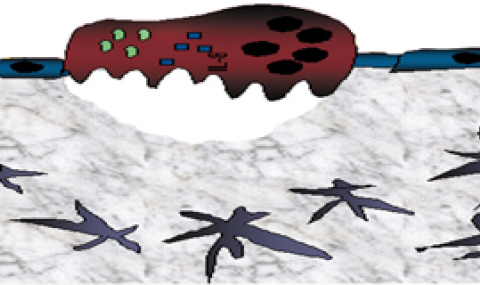Bone marrow (BM) residing hematopoietic stem and progenitor cells (HSPC) replenish the blood with mature cells with a finite life span on a daily basis while maintaining the reservoir of undifferentiated stem cells. We recently showed that light/darkness onset induce two different BM HSPC peaks. Morning-induced norepinephrine and TNF secretion metabolically facilitate HSPC differentiation and egress to replenish the circulation with new mature leukocytes. Night augmented BM melatonin renews BM CD150 + hematopoietic stem cell (HSC) reservoir and their long-term repopulation potential (Golan et al, Cell Stem Cell, In Press). How melatonin primes BM HSPC to change their phenotype and function to re-acquire an undifferentiated and primitive state, is poorly understood. The hormone melatonin is an important mediator of bone formation and mineralization, and ultimately regulates the balance of bone remodeling (Cardinali DP et al, J. Pineal Res., 2003). The cross talk between HSPC and their BM stromal microenvironment is tightly regulated and determines HSPC fate. Therefore, we examined whether melatonin plays a role in regulation of murine BM mesenchymal stem and progenitor cells (MSPC, CD45-/Sca-1 + /PDGFRα + ), known to support HSPC maintenance in their BM niches. Mice treated with melatonin for 5h during the morning had increased levels of BM MSPC endowed with higher colony-forming unit fibroblast (CFU-F) potential in vitro. Interestingly, the metabolic state of these progenitor cells was altered by melatonin demonstrating reduced glucose uptake ability and lower mitochondria content. To test if differences in stromal cells content exist between day and night, we examined BM MSPC and found increased levels at 11PM, the time of melatonin BM peak, with higher Sca-1 high surface expression levels, as compared to daylight 11AM. These changes were associated with augmented CFU-F levels by MSPC harvested at 11PM and accompanied by reduced glucose uptake levels and mitochondria content. Our preliminary results suggest that melatonin at night increases BM MSPC levels and reduces their metabolic activity to maintain them in a primitive and undifferentiated state. Moreover, we found that melatonin-elevated HSPC at 11PM also share lower glucose uptake ability with reduced mitochondria content and lower mitochondrial membrane potential (evaluated by TMRE). We hypothesize that melatonin reprograms the metabolic state of both HSPC and their stromal MSPC microenvironment to renew and maintain a primitive state of both populations at night. One of the factors inhibited by melatonin is the bioactive lipid Sphingosine 1-Phosphate (S1P), which in turn inhibits melatonin production. We found that mice with low S1P levels (S1P low ) due to lack of the SPHK1 enzyme have high BM melatonin levels also during the day in contrast to wild type (WT) mice. S1P low mice had higher levels of primitive stromal progenitor cells including CFU-F and lower levels of differentiating osteoblast precursors compared to WT mice. In addition, these mice had less BM Reactive Oxygen Species (ROS) high committed hematopoietic progenitor cells, but more primitive ROS low EPCR + HSC endowed with higher long-term repopulation capacity in both primary and serially transplanted recipients. Next, we examined how light/dark cues affect the homing of transplanted BM HSPC into the BM of irradiated hosts 18h after transplantation. We found that donor HSPC harvested at 11PM have elevated homing ability compared to 11AM harvested cells. Importantly, MSPC also better homed to the BM of irradiated recipients when we transplanted donor BM cells obtained at 11PM compared with 11AM. As a result, accelerated BM repopulation kinetics was documented one week post transplantation in mice transplanted with BM cells harvested at 11 PM.
Taken together, our results reveal that in vivo melatonin renews and maintains the BM reservoir and function of primitive MSPC and HSPC by metabolically reprogramming these cells during the night on a daily basis. Since the primed HSPC and MSPC at night showed improved function and BM homing potential, these features might be mimicked by human BM cells in order to harness them for improved clinical transplantation protocols.



